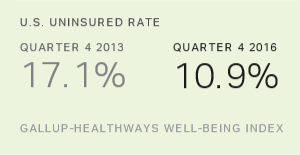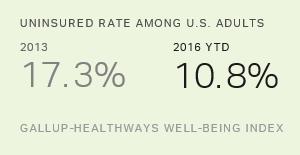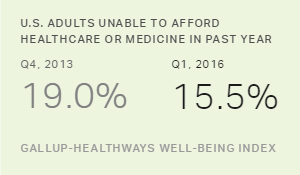Story Highlights
- Rate down 6.2 percentage points since key individual mandate took effect
- Uninsured rate has dropped most among low-income adults, Hispanics
WASHINGTON, D.C. -- The U.S. uninsured rate for health insurance remained at 10.9% in the fourth quarter of 2016. This matches the rate in the third quarter, which in turn marked the record low since Gallup and Healthways began tracking insurance coverage in 2008.

The uninsured rate has fallen 6.2 percentage points from 17.1% in the fourth quarter of 2013. This was just before the implementation of the Affordable Care Act's individual mandate, which compels Americans to carry health insurance or incur a fine. The highest uninsured rate that Gallup has measured since 2008 was 18.0% in the third quarter of 2013, before the health insurance exchanges opened on Oct. 1 of that year.
The 2016 fourth-quarter results are based on approximately 43,000 interviews with U.S. adults aged 18 and older from Nov. 1 to Dec. 30, conducted as part of the Gallup-Healthways Well-Being Index. Gallup and Healthways ask 500 randomly selected U.S. adults daily whether they have health insurance, allowing for trended measurement of the share of Americans who have health insurance over time.

Low-Income Adults and Hispanics See Largest Changes
The largest declines in the uninsured rate since the individual mandate took effect have been among two groups with the highest uninsured rates at that time -- low-income (now at 20.8%) and Hispanic (27.4%) adults. While uninsured rates among both groups have declined by about 10 percentage points between the fourth quarters of 2013 and 2016, they maintain the highest uninsured rates of all major demographic groups. By comparison, high-income adults (2.7%) and white Americans (6.9%) enjoy some of the lowest uninsured rates, though those older than age 65 have the lowest uninsured rate (2.3%) related to their Medicare coverage.
| Q4 2013 | Q4 2016 | Change | |||||||||||||||||||||||||||||||||||||||||||||||||||||||||||||||||||||||||||||||||||||||||||||||||
|---|---|---|---|---|---|---|---|---|---|---|---|---|---|---|---|---|---|---|---|---|---|---|---|---|---|---|---|---|---|---|---|---|---|---|---|---|---|---|---|---|---|---|---|---|---|---|---|---|---|---|---|---|---|---|---|---|---|---|---|---|---|---|---|---|---|---|---|---|---|---|---|---|---|---|---|---|---|---|---|---|---|---|---|---|---|---|---|---|---|---|---|---|---|---|---|---|---|---|---|
| % | % | pct. pts. | |||||||||||||||||||||||||||||||||||||||||||||||||||||||||||||||||||||||||||||||||||||||||||||||||
| National adults | 17.1 | 10.9 | -6.2 | ||||||||||||||||||||||||||||||||||||||||||||||||||||||||||||||||||||||||||||||||||||||||||||||||
| 18 to 64 | 20.8 | 13.1 | -7.7 | ||||||||||||||||||||||||||||||||||||||||||||||||||||||||||||||||||||||||||||||||||||||||||||||||
| 18 to 25 | 23.5 | 14.7 | -8.8 | ||||||||||||||||||||||||||||||||||||||||||||||||||||||||||||||||||||||||||||||||||||||||||||||||
| 26 to 34 | 28.2 | 18.9 | -9.3 | ||||||||||||||||||||||||||||||||||||||||||||||||||||||||||||||||||||||||||||||||||||||||||||||||
| 35 to 64 | 18.0 | 11.0 | -7.0 | ||||||||||||||||||||||||||||||||||||||||||||||||||||||||||||||||||||||||||||||||||||||||||||||||
| 65+ | 2.0 | 2.3 | +0.3 | ||||||||||||||||||||||||||||||||||||||||||||||||||||||||||||||||||||||||||||||||||||||||||||||||
| Whites | 11.9 | 6.9 | -5.0 | ||||||||||||||||||||||||||||||||||||||||||||||||||||||||||||||||||||||||||||||||||||||||||||||||
| Blacks | 20.9 | 12.5 | -8.4 | ||||||||||||||||||||||||||||||||||||||||||||||||||||||||||||||||||||||||||||||||||||||||||||||||
| Hispanics | 38.7 | 27.4 | -11.3 | ||||||||||||||||||||||||||||||||||||||||||||||||||||||||||||||||||||||||||||||||||||||||||||||||
| Less than $36,000 | 30.7 | 20.8 | -9.9 | ||||||||||||||||||||||||||||||||||||||||||||||||||||||||||||||||||||||||||||||||||||||||||||||||
| $36,000 to $89,999 | 11.7 | 9.2 | -2.5 | ||||||||||||||||||||||||||||||||||||||||||||||||||||||||||||||||||||||||||||||||||||||||||||||||
| $90,000+ | 5.8 | 2.7 | -3.1 | ||||||||||||||||||||||||||||||||||||||||||||||||||||||||||||||||||||||||||||||||||||||||||||||||
| GALLUP-HEALTHWAYS Well-Being Index | |||||||||||||||||||||||||||||||||||||||||||||||||||||||||||||||||||||||||||||||||||||||||||||||||||
Plans Paid for by Self See Largest Change
Since the fourth quarter of 2013, the biggest change in the source of insurance among the non-Medicare population (18- to 64-year-olds) has been among U.S. adults who fully pay for their plan, rising 3.7 percentage points to 21.3% in the fourth quarter of 2016. This change likely reflects purchases of health coverage on the health insurance exchanges. Meanwhile, the percentage of Americans receiving their health coverage through an employer has remained largely stable since the last quarter of 2013.
| Q4 2013 | Q4 2016 | Change | |||||||||||||||||||||||||||||||||||||||||||||||||||||||||||||||||||||||||||||||||||||||||||||||||
|---|---|---|---|---|---|---|---|---|---|---|---|---|---|---|---|---|---|---|---|---|---|---|---|---|---|---|---|---|---|---|---|---|---|---|---|---|---|---|---|---|---|---|---|---|---|---|---|---|---|---|---|---|---|---|---|---|---|---|---|---|---|---|---|---|---|---|---|---|---|---|---|---|---|---|---|---|---|---|---|---|---|---|---|---|---|---|---|---|---|---|---|---|---|---|---|---|---|---|---|
| % | % | pct. pts. | |||||||||||||||||||||||||||||||||||||||||||||||||||||||||||||||||||||||||||||||||||||||||||||||||
| Current or former employer | 44.2 | 44.3 | +0.1 | ||||||||||||||||||||||||||||||||||||||||||||||||||||||||||||||||||||||||||||||||||||||||||||||||
| Plan fully paid for by self or family member | 17.6 | 21.3 | +3.7 | ||||||||||||||||||||||||||||||||||||||||||||||||||||||||||||||||||||||||||||||||||||||||||||||||
| Medicaid | 6.9 | 8.8 | +1.9 | ||||||||||||||||||||||||||||||||||||||||||||||||||||||||||||||||||||||||||||||||||||||||||||||||
| Medicare | 6.1 | 7.6 | +1.5 | ||||||||||||||||||||||||||||||||||||||||||||||||||||||||||||||||||||||||||||||||||||||||||||||||
| Military/Veteran's | 4.6 | 4.7 | +0.1 | ||||||||||||||||||||||||||||||||||||||||||||||||||||||||||||||||||||||||||||||||||||||||||||||||
| A union | 2.5 | 2.7 | +0.2 | ||||||||||||||||||||||||||||||||||||||||||||||||||||||||||||||||||||||||||||||||||||||||||||||||
| Something else | 3.5 | 4.6 | +1.1 | ||||||||||||||||||||||||||||||||||||||||||||||||||||||||||||||||||||||||||||||||||||||||||||||||
| No insurance | 20.8 | 13.1 | -7.7 | ||||||||||||||||||||||||||||||||||||||||||||||||||||||||||||||||||||||||||||||||||||||||||||||||
| Gallup-Healthways Well-Being Index | |||||||||||||||||||||||||||||||||||||||||||||||||||||||||||||||||||||||||||||||||||||||||||||||||||
Gallup and Healthways began asking Americans about the source of their health insurance using the current question wording in August 2013, in anticipation of shifts in how people would receive their health insurance after the Affordable Care Act healthcare exchanges went into effect. Gallup asks Americans, "Is your primary health insurance coverage through a current or former employer, a union, Medicare, Medicaid, military or veteran's coverage, or a plan fully paid for by you or a family member?" Gallup also asks if they have secondary health insurance coverage and, if so, what type of coverage it is. The results reported here are a combined estimate of primary and secondary insurance types.
Implications
The government reported that ACA enrollment surged via the exchanges in the days after Donald Trump -- a vocal critic of the healthcare law -- won the presidential election in early November. According to federal officials, 6.4 million people had already purchased healthcare on the ACA exchanges in the open-enrollment period through mid-December, a better-than 6% increase over the same period in 2015. This suggests the uninsured rate could fall further in the first quarter of 2017, setting a new record low. On the other hand, one of Trump's and congressional Republicans' top priorities is to repeal the Affordable Care Act. Their great challenge is to do so in a way that preserves health insurance coverage for 20 million previously uninsured Americans.
Survey Methods
Results are based on telephone interviews conducted Nov. 1-Dec. 30, 2016, as part of the Gallup-Healthways Well-Being Index survey, with a random sample of 42,546 adults, aged 18 and older, living in all 50 U.S. states and the District of Columbia. For results based on the total sample of national adults, the margin of sampling error is ±1 percentage point at the 95% confidence level. Each quarter dating to Quarter 1, 2014, has approximately 43,000 respondents. Each quarter from 2008 through 2013 has approximately 88,000 respondents.
Each sample of national adults includes a minimum quota of 60% cellphone respondents and 40% landline respondents, with additional minimum quotas by time zone within region. Landline and cellular telephone numbers are selected using random-digit-dial methods.
Learn more about how the Gallup-Healthways Well-Being Index works.




